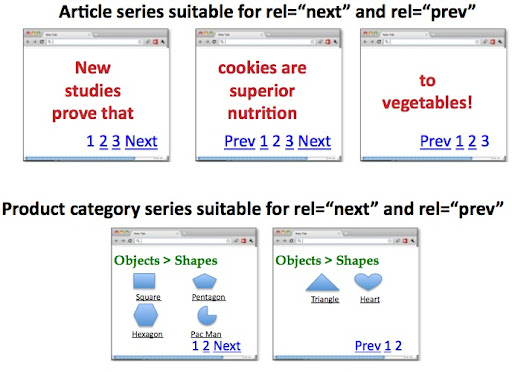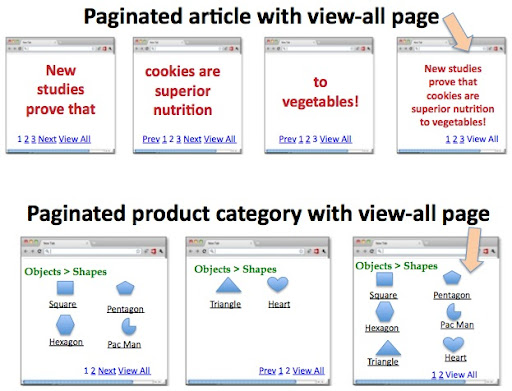Thursday, September 15, 2011
Much like rel="canonical"
acts a strong hint for duplicate content, you can now use the HTML link elements
rel="next" and rel="prev"
to indicate the relationship between component URLs in a paginated series. Throughout the web, a
paginated series of content may take many shapes—it can be an article divided into several
component pages, or a product category with items spread across several pages, or a forum thread
divided into a sequence of URLs. Now, if you choose to include rel="next" and
rel="prev" markup on the component pages within a series, you're giving Google a
strong hint that you'd like us to:
-
Consolidate indexing properties, such as links, from the component pages/URLs to the series as a
whole (that is, links should not remain dispersed between
page-1.html,page-2.html, etc., but be grouped with the sequence). - Send users to the most relevant page/URL—typically the first page of the series.

rel="next" and rel="prev".
There's an exception to the rel="prev" and rel="next" implementation:
If, alongside your series of content, you also offer users a view-all page, or if you're
considering a view-all page, please see our post on
View-all in search results for more
information. Because view-all pages are most commonly preferred by searchers, we do our best to
surface this version when appropriate in results rather than a component page (component pages are
more likely to surface with rel="next" and rel="prev").
If you don't have a view-all page or you'd like to override Google returning a view-all page, you
can use rel="next" and rel="prev" as described in this post.

Outlining your options
Here are three options for a series:
-
Leave whatever you have exactly as-is. Paginated content exists throughout the web and we'll
continue to strive to give searchers the best result, regardless of the page's
rel="next"/rel="prev"HTML markup—or lack thereof. - If you have a view-all page, or are considering a view-all page, see our post on View-all in search results.
-
Hint to Google the relationship between the component URLs of your series with
rel="next"andrel="prev". This helps us more accurately index your content and serve to users the most relevant page (commonly the first page). Implementation details below.
Implementing rel="next" and rel="prev"
If you prefer option 3 (above) for your site, let's get started! Let's say you have content paginated into the URLs:
https://www.example.com/article?story=abc&page=1 https://www.example.com/article?story=abc&page=2 https://www.example.com/article?story=abc&page=3 https://www.example.com/article?story=abc&page=4
On the first page, https://www.example.com/article?story=abc&page=1, you'd include
in the <head> section:
<link rel="next" href="https://www.example.com/article?story=abc&page=2" />
On the second page, https://www.example.com/article?story=abc&page=2:
<link rel="prev" href="https://www.example.com/article?story=abc&page=1" /> <link rel="next" href="https://www.example.com/article?story=abc&page=3" />
On the third page, https://www.example.com/article?story=abc&page=3:
<link rel="prev" href="https://www.example.com/article?story=abc&page=2" /> <link rel="next" href="https://www.example.com/article?story=abc&page=4" />
And on the last page, https://www.example.com/article?story=abc&page=4:
<link rel="prev" href="https://www.example.com/article?story=abc&page=3" />
A few points to mention:
-
The first page only contains
rel="next"and norel="prev"markup. -
Pages two to the second-to-last page should be doubly-linked with both
rel="next"andrel="prev"markup. -
The last page only contains markup for
rel="prev", notrel="next". -
rel="next"andrel="prev"values can be either relative or absolute URLs (as allowed by the<link />tag). And, if you include a<base/>link in your document, relative paths will resolve according to the base URL. -
rel="next"andrel="prev"only need to be declared within the<head>section, not within the document<body>. -
We allow
rel="previous"as a syntactic variant ofrel="prev"links. -
rel="next"andrel="previous"on the one hand andrel="canonical"on the other constitute independent concepts. Both declarations can be included in the same page. For example,https://www.example.com/article?story=abc&page=2&sessionid=123may contain:<link rel="canonical" href="https://www.example.com/article?story=abc&page=2" /> <link rel="prev" href="https://www.example.com/article?story=abc&page=1&sessionid=123" /> <link rel="next" href="https://www.example.com/article?story=abc&page=3&sessionid=123" />
-
rel="prev"andrel="next"act as hints to Google, not absolute commands. -
When implemented incorrectly, such as omitting an expected
rel="prev"orrel="next"designation in the series, we'll continue to index the page(s), and rely on our own heuristics to understand your content.
More information can be found in our Help Center, or join the conversation in our Webmaster Help Forum!
